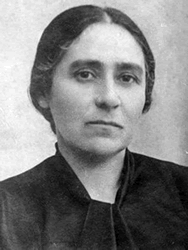Dr. Anna Heller (Braude)
Born on 6 January 1888 in Warsaw, first child in a Jewish traditional family.
She is described as an excellent student, very independent in her views, with special sensitivity to the needs of others.
In 1912, she finished her medical studies and decided to specialize in pediatrics.
Was a member of the Bund party.
In 1913, returned to Warsaw, where she began working in the Jewish hospital in Czyste Street, in the department of Internal Medicine and Neurology.
Shortly before the outbreak of the First World War, she found a job at the children's hospital of Berson and Bauman in Sheina Street.
In 1916 she married Eliezer Heller (1885-1954), an engineer.
They had two sons, the eldest named Ari Leon, and Olum younger.
Soon after, she was forced to leave the Children's hospital (which was closed around this time).
Even after her marriage and the birth of her children, Heller did not abandon her profession.
She took an active part in the establishment of an association (Towarzystowo Przyjaciol Dzieci) whose goals were reopening of the Children's Hospital.
Heller was a central figure in society, work in clinics and in the hospital.
She also promoted the development of social work for children and psychotherapy clinic.
In 1930, Heller re-openned the hospital and was assigned as the manager
A colleague said about her: "As an artist is blessed with divine gifts, she is blessed with God-given talent as a doctor."
In the years between World Wars Olum, her young son, died from illness.
When World War 2 outbroke, the hospital was in the front, treating citizens wounded in the German air raids.
With the establishment of the Ghetto, hospital continued to be used as a hospital for children. Heller saw the hospital as her home. She continued to maintain appropriate medical standards, maintaining a regular routine medical tests, doctors rounds twice a day, orderly reports on patients etc. She also insisted on neat and clean dress and the staff was meticulous about the cleanliness of the hospital itself.
Heller was a member of the Health Council established by the Judenrat and the Ministry of Health.
Heller took part in the clinical research on metabolic changes in the body due to hunger disease. Colleagues spoke about her professionalism, her academic approach and great devotion.
When the mass deportations from the Ghetto began in July 1942, Heller tried to stop the deportation of children from the hospital. Many of the employees of the hospital were sent to Treblinka and Heller had to select a group of employees that the Germans were allowed to remain in the Ghetto.
In the fall of 1942, and again in the winter of 1943, her friends inside and outside the Ghetto urged her to escape to the Aryan side. She refused.
Dr. Anna Braude Heller remained in the bunkers of the Ghetto after the Jewish revolt of April 1943 and perished there.
Her death Circumstances are not known exactly, whether she was burned to death in the bunker with her sister and her friends, or was murdered by the Germans when she left the shelter.
Her son, Ari Leon, survived the war, became a doctor and raised a family.
Article mentioning the son, Ari Heller
Ari Leo HelIer, b.1917, graduated from the Warsaw University Medical School. He worked together with his mother, Dr. Anna Braude-Heller (who headed the Bersohn and Bauman Children's Hospital, where she perished). During the ghetto period he was involved in research on metabolic changes in the hunger disease. He and his family survived on the Aryan side of Warsaw, contrary to the notification of his death. In the post-war period he initially worked in Lublin, and in 12.7.1946 he is listed at the University of Wroclaw. Dr. Helier immigrated to Sweden in 1948, where he became associate professor at the National Bacteriology (Karolinska) Laboratory in Stockholm, a position he held until his death in 2008.
